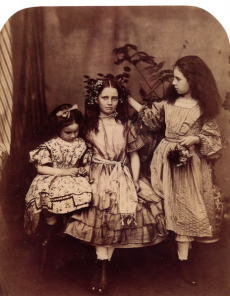
Email: EllaTournes@bexleygs.co.uk
Total Article : 45
About Me:Sixth form student currently studying English Literature, Drama and Theatre Studies, Classical Civilisation and History.

As one of our main dramatic intentions for our Year 13, was to draw parallels between the real-life context, and the fictional events in 'Alice in Wonderland', we started our devising process by listing the main events of each, parallel to each other, and seeing where we could find potential links and similarities. For example, we linked Mrs Liddell’s judgement over Charles Dodgson's relationship with Alice, after the finding the diary with the incriminating pictures of Alice inside, with the Queen of Heart’s trial in Chapter 11 of ‘Alice in Wonderland’. Making these lists made the transitions between our 'Wonderland' scenes and our 'real-life' scenes smoother, as well as making them more meaningful – bridging the gap between the fictional and the contextual made our whole play more relevant.
One of our biggest challenges was to convey the issue of paedophilia in a sensitive, subtle manner. During the scene in which the audience sees Charles Dodgson's feelings begin to intensify, as some of his words from his diary are acted out in a Frantic Assembly ‘chair duet’. We struggled to find movements for this that weren't overtly sexual, but still conveyed the intense relationship we wanted the audience to see. We didn't want to completely demonise the character of Dodgson by starkly, and incorrectly portraying him as an indisputable paedophile. We wanted to explore the complexity of Dodgson's feelings, and we still wanted our audience to keep the audience’s pathos for him throughout the piece. To do this, we used Frantic Assembly's 'through-by-round' technique, to create the basic elements of the movement first, then add meaning to them after. This allowed us to experiment with more subtle elements, like proxemics, breath, pace and facial expressions, to convey their relationship, rather than overtly sexual movements that we’d experimented with before. We started off with the very simple movement of Alice touching Carroll’s arm. We then altered it slightly, by slowing down the movement once the connection had been made, and almost freezing it once the two characters had gained eye contact. We then experimented with breath, making it heavier and slower as the pace of the moment got slower. This made the moment subtler, and more effective.
During our 'Mad Hatter' scene, one of our main focuses was on making the audience feel uncomfortable and invaded. During our rehearsal process, we practised running the scene in front of different audiences and gaging, from their reactions, what was effective and what wasn’t. We experimented with Laban efforts, attempting the scene in a sudden, fast-paced way, then attempting it in a sustained, slow-paced manner. We realised that lurching between these two dynamics was the most effective for startling and invading the audience – for example, slowly walking towards the audience, whispering the line, ‘I have a riddle for you’, then slamming down on a table in front of the audience, suddenly moving our faces towards them, and quickly shouting the line ‘Why is a Raven like a writing desk?’, is more effective than just shouting at the audience throughout the scene, because the change in our pace is unexpected.
Sources:https://www.google.co.uk/search?q=lewis+carroll&espv=2&biw=1366&bih=662&site=webhp&source=lnms&tbm=isch&sa=X&sqi=2&pjf=1&ved=0ahUKEwjM9f3WyZ_SAhVJIsAKHcmcAIIQ_AUIBigB#tbm=isch&q=lewis+carroll+art&imgrc=Cju8HWGwDqXYMM:

0 Comment:
Be the first one to comment on this article.